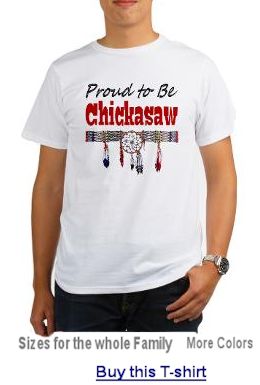The Chickasaw Nation is a federally recognized Native American nation, located in Oklahoma. They are one of the members of the Five Civilized Tribes. The Chickasaw Nation was created after the Chickasaw people were forcibly removed by the US federal government to Indian Territory in the 1830s.
Official Tribal Name: The Chickasaw Nation
Address: 520 E. Arlington, P.O. Box 1548,
Ada, Oklahoma 74821
Phone: (580) 436-2603
Email: Contact Form
Official Website: www.chickasaw.net
Recognition Status: Federally Recognized
Traditional Name / Traditional Meaning:
Chikasha – The name of a legendary tribal chief.
Common Name: Chickasaw
Meaning of Common Name: Chickasaw – From Chikasha
Alternate names: Five Civilized Tribes
Alternate spellings / Mispellings:
Name in other languages:
Region: Great Plains
State(s) Today: Oklahoma
Traditional Territory:
Confederacy: Five Civilized Tribes
Treaties:
Reservations:
Land Area:
Tribal Headquarters:
Time Zone:
B.I.A. Office:
Population at Contact:
Registered Population Today:
Tribal Enrollment Requirements:
Genealogy Resources:
Black Chickasaws adopted through the Dawes Commission between 1898 and 1916
Government:
Charter:
Name of Governing Body:
Number of Council members:
Dates of Constitutional amendments:
Number of Executive Officers:
Elections:
Language Classification:
Language Dialects:
Number of fluent Speakers:
Dictionary:
Origins:
Related Tribes: The Five Civilized Tribes are the Cherokee, Chickasaw, Choctaw, Creek (Muscogee), and Seminole. They are so called because they were some of the first tribes to adopt European culture as their own.
Traditional Allies:
Traditional Enemies:
Choctaw – The Chickasaw and Choctaw were once one tribe.
Ceremonies / Dances:
Modern Day Events & Tourism:
Legends / Oral Stories:
Art & Crafts:
Animals:
Clothing:
Adornment:
Housing:
A traditional Chickasaw town or village consisted of several compounds or households. Each household contained a winter house, summer house, corn storage building or “corn crib” and menstrual hut. Some Chickasaw towns were reported to have numbered over two hundred households. In addition, each village had a log palisade fort, council, ceremonial and ball grounds and a ceremonial rotunda and council house for the conducting of religious exercises and local government.
Subsistance:
The Chickasaw planted the three sisters – corn, squash and beans.
There are many offerings that are considered traditional Chickasaw recipes. Most notably this includes grape dumplings, Indian fry bread and pishofa. You can find these recipes and other traditional Chickasaw fare in Ilimpa’chi’ (We’re Gonna Eat!): A Chickasaw Cookbook by JoAnn Ellis and Vicki May Penner.
Economy Today:
Religion Today:
Traditional Religion & Spiritual Beliefs:
The Chickasaws do not have a tradition of a time when they were without belief in a supreme being, who is called Abaꞌ Binniꞌliꞌ (Sitting or Dwelling Above) also called Inki Abu (Father Above) under Christian influence.
There were ancient beliefs in a multitude of celestial powers. There were four “Beloved Things” above: the clouds, the sun, the clear sky and “He that lives in the clear sky.”
It was believed that Abaꞌ Binniꞌliꞌ lived above the clouds and on earth with “unpolluted” people. He is the sole creator of warmth, light and all animal and vegetable life. The Chickasaws worshipped Abaꞌ Binniꞌliꞌ, “in smoke and cloud, believing him to reside above the clouds and in the element of the holy fire.”
Lightning and thunder were called Hiloha (Hiloha-thunder) and its rumbling noise ROWAH. When it rained, thundered and strong winds blew for a long time; the beloved or holy people were thought to be at war above the clouds. Many Chickasaw used to fire off their guns, pointed at the sky, at such times. This was to show that the warriors were not afraid to die so that they could aid the holy people.
Fire was very much respected by the ancestors. Trees were deadened and later used to keep the annual holy fire burning. It was unlawful—and considered the work of evil spirits—to extinguish even the cooking fire with water.
In ancient times, Chickasaws placed great importance and meaning on those locations defined as important by history and tribal religion. The great migration legend, describing how the tribe moved from the “place of the setting sun” to the east as ordained by Abaꞌ Binniꞌliꞌ (God), was central in explaining the importance of the homelands.
Explanations of natural phenomena and descriptions of one’s place in the universe were common themes as well. Chickasaw elders conveyed ancient knowledge as a sacred obligation, thereby instilling in younger generations cultural identity and tribal cohesiveness. The stories of the elders had significance in describing tribal history, not in terms of chronological dates, but more in terms of how events and locations impacted nature and people.
Burial Customs:
Wedding Customs:
Newspapers:
Radio:
Chickasaw Chiefs and Famous Chickasaw
Catastrophic Events:
Tribe History:
The following video gives a broad overview of Chickasaw history.
In the News:
Further Reading:


